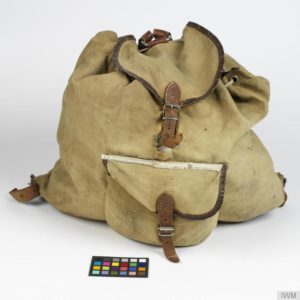
Rucksack, c. 1940s, held by Imperial War Museum.
Despite seeing images all over the news of refugee children, it is still very hard for us imagine what it would be like to have to leave your home, your family, your country. To get on a train or a boat, not knowing where you are going but suspecting that you may never see your family again. This was the situation for thousands of Jewish children who left central Europe before the start of WWII. This was called the Kindertransport. There have been many occurrences of unaccompanied minors being sent away from conflict zones for their own good, to save their lives.
Around 10,000 children were saved in the Kindertransport.
And for the girls, the journey was particularly hard. Often, older girls had to look after younger siblings and other children they found themselves travelling with. The deep sense of loss over their families had to be quickly packed away to be strong and help the ones who were too young to understand what was happening.
This rucksack belonged to Lore Heinemann (née Benjamin), who arrived in Britain from Germany on 3rd May 1939. She later recounted her experiences and feelings in this poem:
Rucksack, you have served me well 60 years, and lots to tell
Understanding most our travel plenty mysteries to unravel Cologne, Holland,
Hook to Harwich Liverpool Station we arrived Kindertransport, 10000 children all survived.
School next week, and hostel strife thanks to Britain, we’re alive.
Artists, professors and musicians
Craftsmen, soldiers, politicians
Knowledge, books and recreations teaching future generations.
The children were not allowed to take very much with them on the journey. This was very difficult because you needed clothes, but also objects to bring you comfort. Here’s the list of what girls were told they could bring:
- 12 dresses
- 2 coats
- Shoes
- Nightwear
- Towels, toothbrushes, face cloths
- Books, pens, notebooks
- Photographs, toys, dolls etc.
These are the things from which they were to build entirely new lives in a new country, most likely Britain. And many of these girls did go on to accomplish important things in the world, some never forgetting what happened and other desperately trying to.
WWII and the Kindertransport mark a time in our history that showed our capacity for both great inhumanity as well as compassion towards our fellow people.
-Ashley E. Remer
Head Girl
Girl Museum Inc.
For more information about girls in the Kindertransport, check out our exhibition.
This post is part of our 52 Objects in the History of Girlhood exhibition. Each week during 2017, we explore a historical object and its relation to girls’ history. Stay tuned to discover the incredible history of girls, and be sure to visit the complete exhibition to discover the integral role girls have played since the dawn of time.
